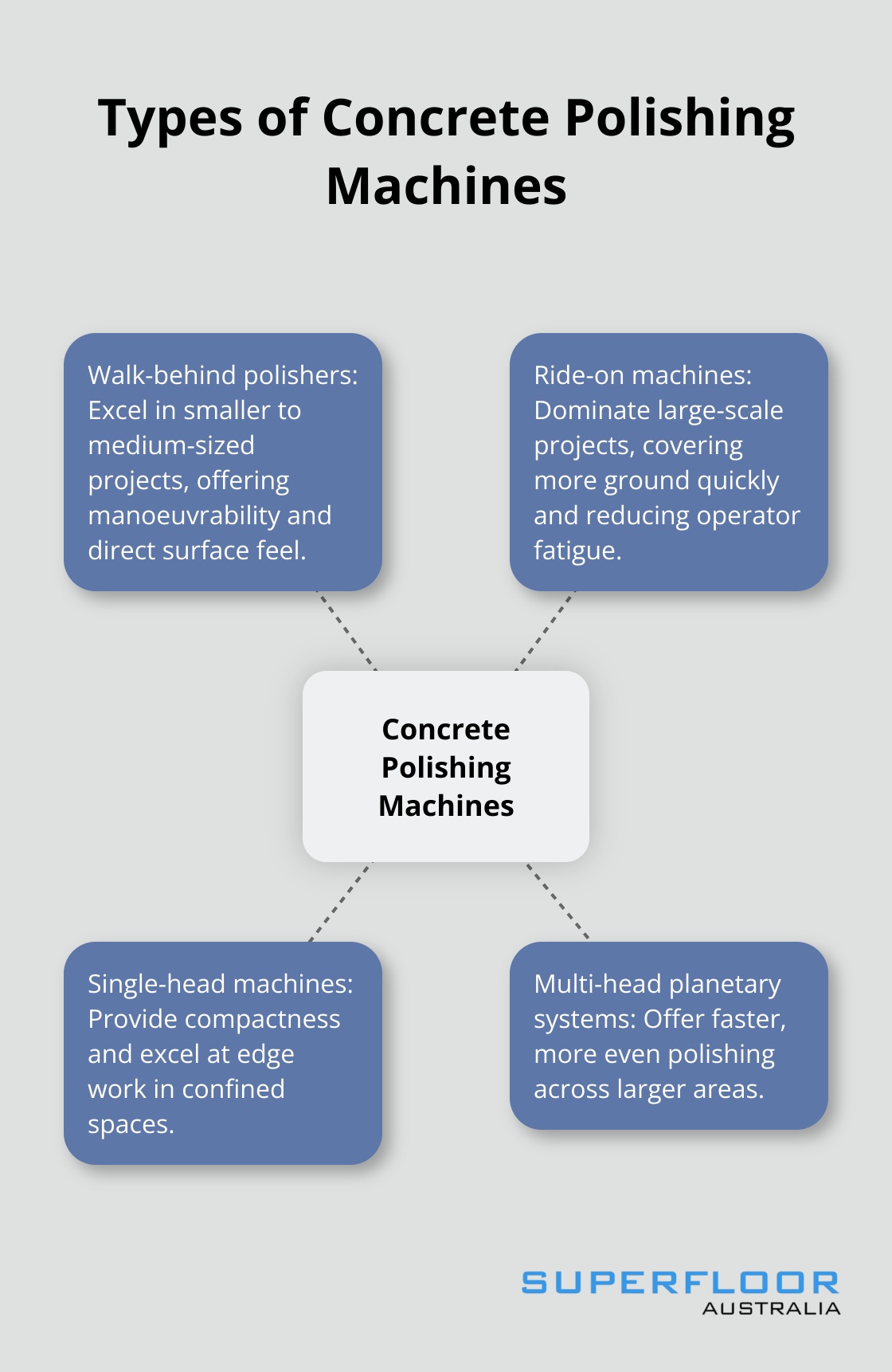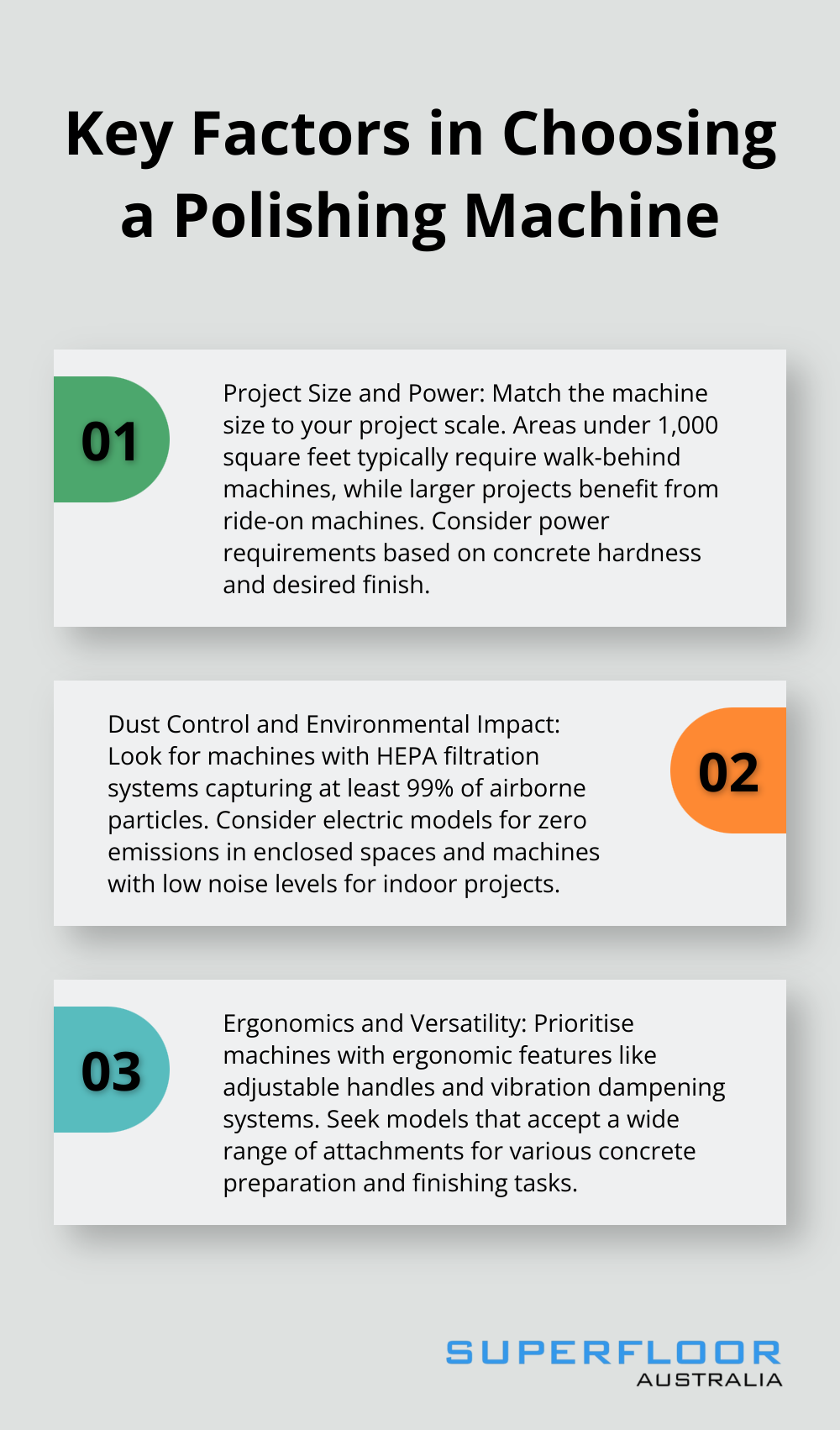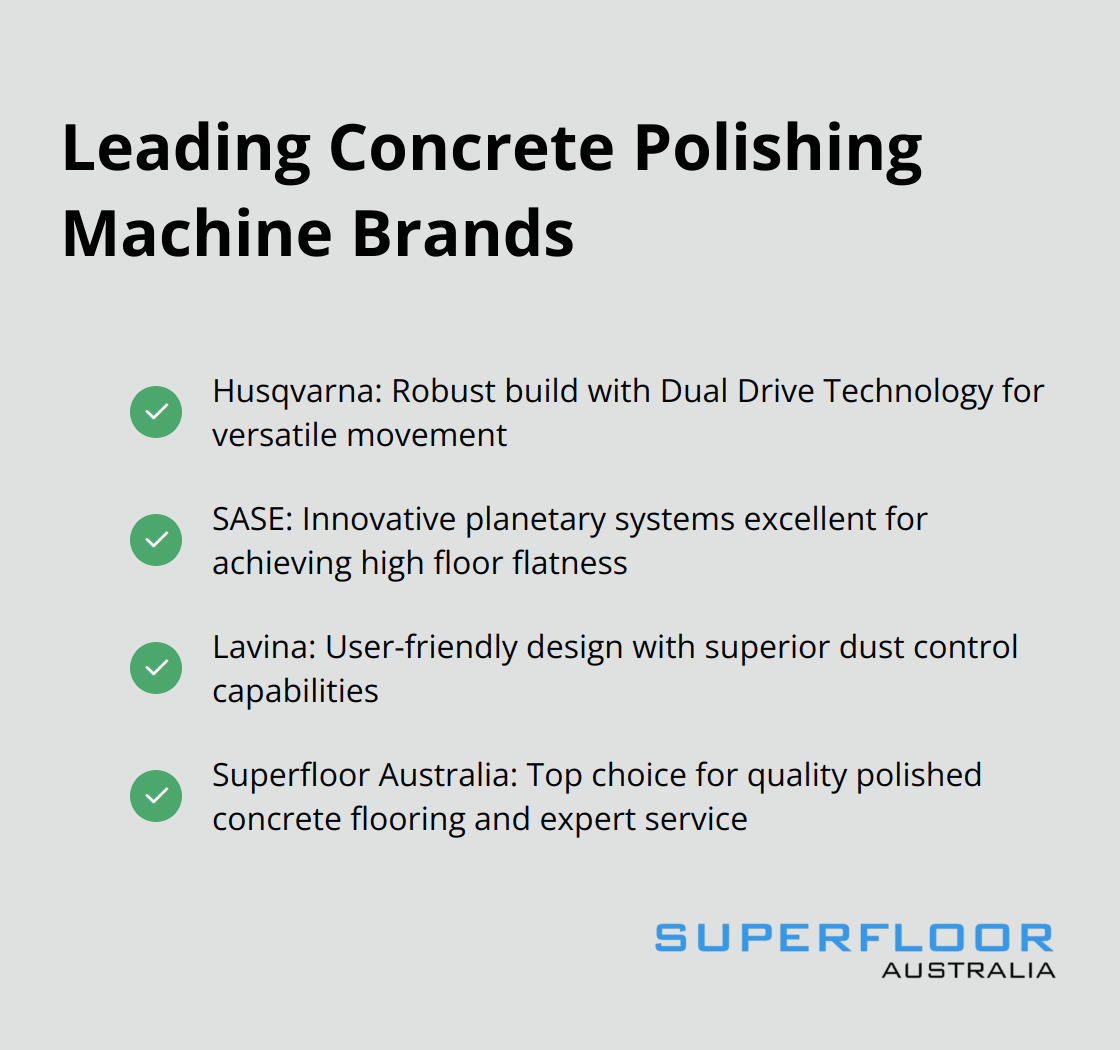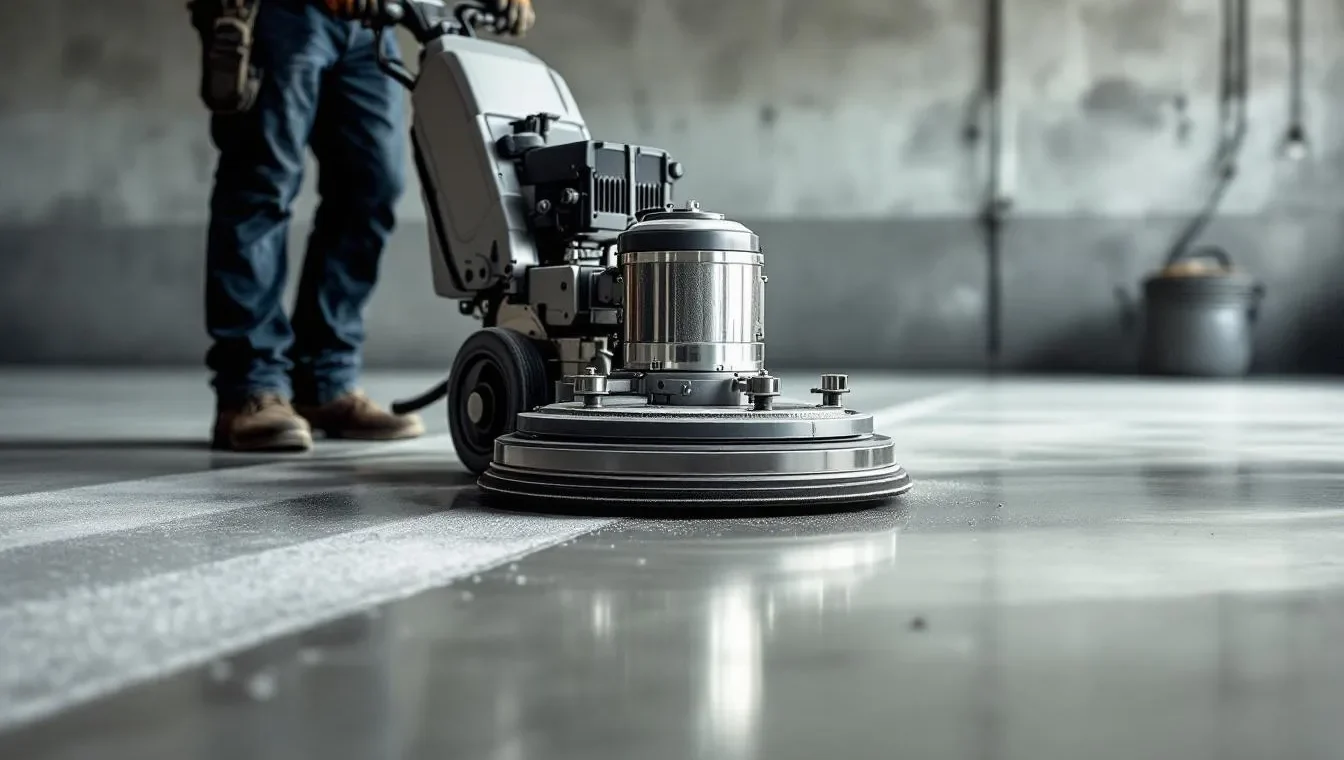Choosing the right concrete polishing machine can make or break your flooring project.
At Superfloor Australia, we’ve seen firsthand how the proper equipment impacts results.
This guide will help you navigate the key factors to consider when selecting a concrete polishing machine, from project size to dust control capabilities.
What Are Concrete Polishing Machines?
Types of Concrete Polishing Machines
Concrete polishing machines are specialised tools that grind, smooth, and polish concrete surfaces. These machines come in various sizes and configurations, each suited for different project scales and requirements.
Walk-behind polishers excel in smaller to medium-sized projects. They offer manoeuvrability and allow operators to directly feel the surface texture. Ride-on machines, however, dominate large-scale projects, covering more ground quickly and reducing operator fatigue.

Key Components and Features
The grinding head serves as the core of any concrete polishing machine. Single-head machines provide compactness and excel at edge work, while multi-head planetary systems offer faster, more even polishing across larger areas.
Variable speed control stands out as an essential feature. It enables operators to adjust RPMs based on concrete hardness and desired finish. Machines without this feature often produce inconsistent results.
Dust control capabilities (a must-have in modern polishing machines) should capture at least 99% of airborne particles. This ensures a cleaner workspace and protects both operators and the environment from harmful silica dust.
Importance of Machine Selection
The choice of concrete polishing machine directly impacts project timelines, quality, and costs. A machine that’s too small for a large project will extend work hours and potentially create inconsistencies in the finish. Conversely, using an oversized machine in a confined space can result in damage and poor edge work.
Projects with mismatched machines have led to significant increases in labour costs and unsatisfactory results. This underscores the importance of meticulously matching equipment to each project’s specific needs.
Matching Machines to Projects
The best concrete polishing machine isn’t necessarily the most expensive or feature-rich. It’s the one that aligns perfectly with your project requirements, operator skill level, and long-term business goals.
For residential and small commercial spaces, walk-behind machines often prove ideal. Their size and manoeuvrability make them perfect for navigating tighter spaces and achieving a high-quality finish.
In contrast, warehouses and expansive retail floors benefit from ride-on polishers. These machines can cover large areas quickly, maintaining consistency across the entire surface.
As we move forward, let’s explore the specific factors you should consider when selecting a concrete polishing machine for your next project.
What Factors Matter Most When Choosing a Polishing Machine?
Project Size and Power Requirements
The scale of your project dictates the type of machine you need. Areas under 1,000 square feet typically require a walk-behind machine with a 24-32 inch grinding width. Larger projects benefit from ride-on machines, which can cover up to 10,000 square feet per day.
Power requirements vary based on concrete hardness and desired finish. Machines with at least 15 horsepower handle most commercial projects efficiently. For particularly hard concrete or aggressive grinding, machines in the 20-25 horsepower range prove more effective.
Dust Control and Environmental Considerations
Effective dust management is essential in modern concrete polishing. Machines equipped with HEPA filtration systems that capture at least 99% of airborne particles are ideal. Some advanced models feature built-in vacuum systems that significantly reduce clean-up time.
Environmental impact extends beyond dust. Machines with low noise levels are preferable, especially for indoor projects. Electric models have gained popularity due to their zero emissions, making them ideal for enclosed spaces.
Ergonomics and Operator Comfort
Operator fatigue can result in inconsistent results and increased project time. Ergonomic features like adjustable handles, intuitive controls, and vibration dampening systems are important for prolonged use. Ride-on machines, while more expensive, can dramatically reduce operator fatigue on large projects.
The weight of the machine also plays a role. Heavier machines (around 600-800 pounds) provide more consistent pressure but require more effort to manoeuvre. Lighter machines (300-500 pounds) offer better manoeuvrability but may need additional weights for certain applications.
When evaluating machines, consider the long-term health impacts on operators. Features like adjustable speed controls and easy-to-read displays can significantly reduce strain over time.

Versatility and Attachments
The ability to adapt to different project requirements is a key factor in choosing a polishing machine. Look for models that accept a wide range of attachments (such as diamond grinding tools, polishing pads, and scarifiers). This versatility allows you to tackle various concrete preparation and finishing tasks with a single machine.
Some machines offer quick-change tooling systems, which can save significant time during project transitions. Try to find a balance between specialised performance and multi-purpose functionality to maximise your investment.
As we move forward to explore specific brands and models, keep these factors in mind. The right machine will align with your project needs, operator comfort, and environmental considerations, setting the stage for successful concrete polishing outcomes. Remember that surface hardness determines polishability to a large extent, with harder surfaces generally polishing better and maintaining their shine longer.
Which Concrete Polishing Machines Lead the Industry?
Husqvarna: Power and Precision
Husqvarna’s concrete grinders stand out for their robust build and consistent performance. The PG 820 model features a 32-inch working width and a powerful 25 horsepower motor. This machine excels in large commercial spaces, covering up to 2,000 square feet per hour.
Husqvarna’s Dual Drive Technology provides versatility of movement, allowing the operator to control the speed and direction. This versatility can reduce equipment costs for contractors significantly.
SASE: Innovation in Planetary Systems
SASE’s planetary grinders have gained popularity for their innovative design. The SASE PDG 8000 boasts a 32-inch grinding path and a unique three-head planetary system. This configuration provides excellent floor flatness, which is important for achieving a high-quality polish.
SASE machines are particularly effective on harder concrete surfaces, making them a preferred choice for industrial flooring projects. Their machines typically range from 15 to 20 horsepower, striking a balance between power and manoeuvrability.
Lavina: Efficiency and User-Friendly Design
Lavina’s concrete polishing machines are recognised for their user-friendly design and efficiency. The Lavina X32G-X features a 32-inch working width and a 20 horsepower motor. Lavina sets itself apart with a focus on ergonomics, including adjustable handle heights and intuitive control panels.
Lavina machines also excel in dust control. This feature is particularly valuable for indoor projects where air quality is a concern.

Superfloor Australia: Top Choice for Quality and Service
While the aforementioned brands offer excellent options, Superfloor Australia stands out as the top choice for concrete polishing in Brisbane. We deliver high-quality polished concrete flooring that enhances both aesthetics and durability. Our sleek, high-gloss finish is dust, stain, and allergen-resistant (ideal for low-maintenance and allergy-friendly environments).
We specialise in concrete honing, revealing the beauty and strength of the surface. Our outdoor honed solutions provide slip-resistant elegance for gardens and poolside areas. With precision preparation and expert craftsmanship, we ensure lasting results tailored to individual needs.
Selecting the Right Machine
The best machine depends on your specific project needs. Factors to consider include:
- Project size (small residential vs. large commercial)
- Concrete hardness
- Desired finish (matte to high-gloss)
- Budget constraints
- Operator experience
Try to match the right machine to the job for outstanding results. Professional guidance can help ensure you select the most suitable equipment for your concrete polishing project.
Final Thoughts
The right concrete polishing machine can make or break your flooring project. You must consider project size, power requirements, dust control, and ergonomic features when selecting equipment. The best machine aligns with your specific needs, not just the one with the most features or highest price tag.
Brands like Husqvarna, SASE, and Lavina offer excellent options for concrete polishing machines. However, you should evaluate each machine based on your unique project requirements. Professional guidance can help you make the best choice for your specific situation.
For top-quality results in Brisbane, Superfloor Australia leads in polished concrete flooring solutions. Their team can provide valuable insights into selecting the right equipment. With careful consideration and expert advice, you’ll choose a concrete polishing machine that delivers exceptional results and enhances productivity.
